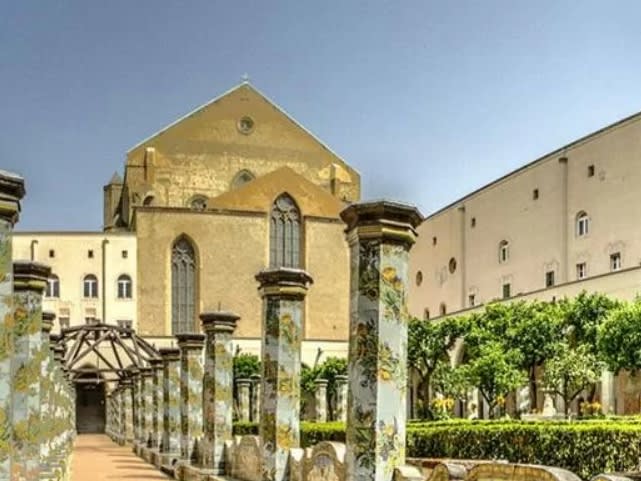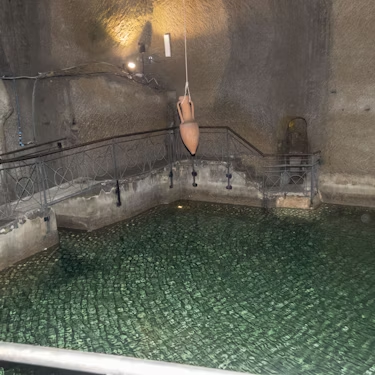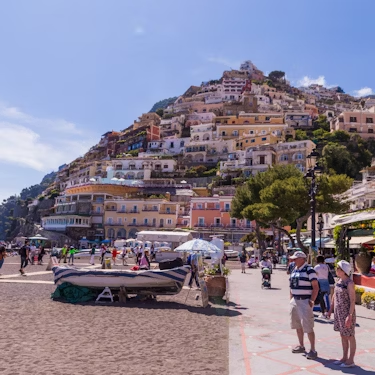More about: Best Things To Do In Naples In 2 Days
Looking for what to see and do in Naples? Great! This article will be of great help to you. The journey touches several points of the city trying to give an overview of the city of Vesuvius.
Since we are in the south of Italy, the route includes some gastronomic stops recommended by the locals. Ready to lick your fingers?
Day 1: Tour the center of Naples

Your two days in Naples must necessarily start in Piazza Plebiscito, an iconic place of the capital of Campania.
Start your visit at Piazza del Plebiscito
It isthe symbol of Naples and the most important square in the city. The Palazzo della Prefettura, Palazzo Salerno, Palazzo Reale and the Church of San Francesco di Paola enclose an area of over 25 thousand square meters.
In the center stand out the two equestrian statues dedicated to Charles III of Bourbon and his son Ferdinand I, made by Canova and his pupil Antonio Calì.
Before the unification of Italy, this square was known as "Largo di Palazzo" and became the current name in October 1860 when a plebiscite established the union of the former territories of the Kingdom of the Two Sicilies with the newly born Italian monarchy.
As in other cities, in the 1960s it became a large parking lot and cars resisted in the square until 1994.
Fortunately, today it is completely pedestrianized and due to its large size hosts events of all kinds, from concerts to political demonstrations. If you visit Naples at Christmas time you will admire the large tree that adds a festive touch to the square.
Have breakfast at the Gran Caffè Gambrinus
To start the day with the right dose of energy there is nothing better than a sfogliatella, a typical dessert with a history dating back to the Middle Ages.
It is a puff pastry with a crunchy wrapper and a filling of ricotta (ricotta cheese) and semolina. Traditionally there were two versions, riccia and frolla, but today there are dozens of modern recipes.
In the heart of Naples, the best place to try them is the Gran Caffè Gambrinus. It is a historic bar characterized by elegant Art Deco interiors and, of course, by the quality of its creations. It is located in Via Chiaia 1, a stone's throw from Piazza Plebiscito.
Visit the Castel Nuovo

From the Gran Caffè Gambrinus, go past Piazza del Carciofo and take Via San Carlo. You will soon arrive in front of Castel Nuovo or Maschio Angioino, the fortress built at the behest of Charles I of Anjou after defeating the Suevi in 1266. This victory was very important for the city as it marked the transfer of the capital of the kingdom from Palermo to Naples.
The castle has a trapezoidal plan surrounded by five towers. The courtyard includes Catalan elements such as the portico with segmental arches and the external staircase in magmatic rock. The main room is the Sala dei Baroni, which once housed the throne and a series of frescoes by Giotto.
You can visit it from Monday to Saturday, from 9:00 to 19:00. As for the price, you will have to pay about 6 €. Occasionally, on Sundays the entrance is free.
Stroll through the Galleria Umberto I
This elegant pedestrian promenade was built in the late nineteenth century with a dual function: commercial and monumental. The main entrance is located in Via San Carlo, a stone's throw from the Maschio Angioino.
When you arrive here you will see its exedra façade and the four marble statues representing Europe, Asia, Africa and America.
Shortly after its inauguration it became the epicenter of the Neapolitan Belle Epoque. The exponents of the local bourgeoisie came here to stroll under the splendid glass and steel vault, go shopping and enjoy the shows of the Salone Margherita, the first cafè-chantant in Italy.
More than a century later, the Galleria Umberto I remains the salon of Naples and an essential stop on any trip to the city.
To get to the next stop, you will have to exit from the Via Toledo access that leads to the shopping street of the same name.
Follow the road in Via Toledo
Exit the gallery in the opposite direction of the sea and you will reach the most important street of Naples. It was built in the sixteenth century by the will of Viceroy Pedro Alvarez de Toledo; that is why it is dotted with elegant buildings such as the Zevallos Palace and the Doria d'Angri Palace.
It is also the commercial street of the city and is completely pedestrianized. Here you will find the best-known brands - H&M, Disney, Pull & Bear, etc. - but also bars and historical stores.
If you have time, I recommend getting off at the metro station of the same name, the third most beautiful in Europe according to CNN.
Admire the jewels of Cappella Sansevero

A few minutes' walk from Toledo Street is a haunted place: the Sansevero Chapel. Its most famous icon is the Veiled Christ, an extraordinary marble sculpture that reproduces the texture of a veil. The other statues and the structure of the temple are no less beautiful and certainly worth a visit.
The church is normally open from 9:00 to 18:30 but you should book in advance. There are often queues and seating is limited.
To organize your visit, I recommend you to read carefully the article on tickets and visits to the Veiled Christ of Naples.
Enjoy the panorama at the Belvedere San Martino
After the visit, exit the chapel and reach the Montesanto funicular stop (line F2). You will get off at Morghen which is about 600 meters from this wonderful viewpoint.
There are several viewpoints in the city, but this one has something peculiar: from here you can see a 360° view that embraces the entire city, from the gulf to the summit of Vesuvius.
Spend the afternoon at the Vomero
The Vomero is a neighborhood in the hills of Naples conceived as a residential area for the wealthy classes. Belvedere San Martino is located in the same district, although the central area is at the foot of Castel Sant'Elmo.
Fortunately, to get there you only have to go down the Pedamentina, a historic staircase that connects the old town with the castle of Sant'Elmo.
Its crown jewel is Villa Floridiana, a neoclassical mansion built for Lucia Migliaccio, Duchess of Floridia and wife of Ferdinand IV of Bourbon. It is surrounded by a large park - one of the largest in Naples - crisscrossed by paths and adorned with statues, columns and other architectural elements that reproduce Greco-Roman ruins.
It is a paradise for children who can run and play in its large lawns. Children's playgrounds are near the entrance to Via Cimarosa, a stone's throw from the camellia grove.
The opening hours depend on the season: from 8:00 am to 4:30 pm in winter and from 8:30 am to 7:30 pm in summer.
By the way, if you are looking for other activities designed for the little ones, I recommend you to read the post about visiting Pompeii with children.
Shopaholics find in the Vomero their ideal destination. The most famous stores are concentrated in the streets Via Luca Giordano and Via Alessandro Scarlatti. However, the neighborhood's side streets and alleys are home to lesser-known stores where you can find some bargains.
Delight your palate at Buatta
In the Vomero district is Buatta, a restaurant that serves delicious traditional cuisine.
It defines itself as a "Trattoria di conversazione" (inn of conversation); this means that you can enjoy both the food and the popular atmosphere without rushing: in Naples they know well the value of the after-dinner conversation!
One of their star dishes is genovese, an excellent pasta sauce prepared with beef and plenty of onions. Another particular recipe is spaghetti d'o puveriello, prepared with eggs, pork fat and cheese. A classic of poor cuisine. The restaurant is located in Via Filippo Cifariello 14.
If you are passionate about good food I recommend you to read the post about the best gastronomic tours in Naples. The city of Vesuvius has a wide offer of street food and traditional snacks.
Day 2: the most authentic Naples

The route of the second day starts in a place of medieval Naples: the Complesso Monumentale di Santa Chiara. If you are not staying nearby, you can get here by getting off at the metro stops "Duomo" or "Università".
Delve into the history of the Complesso Monumentale di Santa Chiara
The Complesso Monumentale di Santa Chiara is a Franciscan citadel dating back to the 14th century. It was built by the will of King Robert of Anjou and his wife, Sancha of Majorca, and occupies a fairly large area in the center of Naples.
The architects Gagliardo Primario and Leonardo di Vito designed this temple in Provençal Gothic style. The sculptures were made by Tino da Camaino who specialized in funeral monuments.
To decorate the interior, Robert of Anjou chose the best painter of the time, Giotto, although some believe that the frescoes were made by one of his pupils.
The most famous part is undoubtedly the Chiostro Maiolicato, a cloister decorated with majolica tiles with floral motifs. It is an oasis of peace with a discreet charm. If you want to get an idea, you can take a look at its Instagram profile. Open every day from 9:30 am to 5: 30 pm (Sundays from 10:00 am to 2:30 pm).
Find a souvenir in Via San Gregorio Armeno
A Naples Christmas classic that can be enjoyed in any month of the year. This street in the old town hosts the ancient workshops of the artisans of the nativity scene.
The vocation of Via San Gregorio Armeno precedes Christianity. At the time of ancient Rome, the Temple of Ceres was located here and the stores in the area sold terracotta statuettes that were offered to the goddess of fertility.
Today, here you can find everything from classic Neapolitan nativity scene figures to statuettes of famous contemporaries. As for the stores, these are the most historic:
- Fratelli Capuano, in 2002 they were in charge of the nativity scene at the Royal Palace in Madrid (Via San Gregorio Armeno 28).
- Sciuscià, a store specialized in "scogli", nativity scenes that revive 17th century Naples (Via San Gregorio Armeno 3).
- Gambardella. In addition to the traditional figures, you will find reproductions of Freddie Mercury, Diego Maradona, Fidel Castro and other characters (Via San Gregorio Armeno 40).
- Di Virgilio, another temple of the Neapolitan nativity scene. In this establishment you can even order personalized statuettes. The quality is very high (Via San Gregorio Armeno 18).
- Ferrigno, in addition to the figurines you can buy home fragrances, lucky charms, hand-painted ceramics and much more (Via San Gregorio Armeno 8).
Order a margherita at Antica Pizzeria da Michele

Naples is synonymous with pizza and the establishment on Via Cesare Sersale is its temple. Although we are used to long menus and elaborate toppings, here they bring out only two versions: marinara (tomato, oregano, basil) and margherita (tomato, fiordilatte and basil).
Contrary to what you might think, no bell buffalo mozzarella is used but fiordilatte, a fresh cheese obtained exclusively from cow's milk. The choice of ingredient is reflected in the cooking: it is firmer and guarantees a better result.
Another myth to dispel is linked to oil: Antica Pizzeria da Michele uses seed oil and not olive oil so that the intense flavor of the latter does not cover the flavors.
The restaurant is open every day of the week from 11:00 to 23:00. It is very well known and you will often have to wait a bit to get in; however, I assure you it is worth it - Da Michele has been baking pizzas since 1870!
Enter the Duomo
The Neapolitan cathedral is in Gothic style, with a Latin cross structure and three naves. However, the construction we can appreciate today is the result of several modifications. One of its naves leads to the Basilica of Santa Restituta, a church dating back to early Christian times.
It can be visited from Monday to Saturday from 8:30 am to 2:30 pm (with a break between 1:30 pm and 2:30 pm) and on Sundays from 8:00 am to 7:30 pm with a break between 1:00 pm and 4:30 pm.
Tour the Archaeological Museum
If you are passionate about Roman and ancient art, a visit to the Archaeological Museum of Naples should be on your list.
The itinerary is divided into three sections: the Pompeian collections, the Farnese collection (which belonged to the noble family of the same name) and the Egyptian collection, the third largest in the world after Cairo and the Egyptian museum in Turin. The museum is open from 9:00 a.m. to 7:30 p.m..
Experience the most authentic Naples at Rione Sanità
Until a few years ago, the Rione Sanità remained outside the traditional tourist circuits while today it is a very popular destination.
Before the 17th century the area was practically abandoned but everything was destined to change. The construction of the basilica of Santa Maria della Sanità and some residences of the wealthy classes changed its physiognomy.
In fact, the real protagonist of the district is the Maddalena Cerasuolo bridge, which connects the center with the Reggia di Capodimonte. If on the one hand it improved the connections with the rest of the city, on the other hand it maintained the essence of the district.
Strolling in the streets of Rione Sanità means soaking in the most popular Naples, between clothes hanging outdoors and the buzz of tomato sauce simmering.
Here you can take a graffiti route (in Vico Misericordiella, Vico Buongiorno, Vico Lammartari and Salita Fontanelle, among others), try the tuna and provola sandwich at Alimentari Carmine (Via Sanità 115) or visit the Church of San Severo outside the walls.
No walk through the neighborhood should exclude a route under its elegant buildings. The most famous are Palazzo Sanfelice (its monumental open staircases are very scenographic) and Palazzo dello Spagnuolo, one of the most beautiful examples of Neapolitan baroque.
Discover the ritual of the Cimitero delle Fontanelle

The Rione Sanità has another illustrious guest: the Cimitero delle Fontanelle. It is an ossuary containing the mortal remains of an undetermined number of people who died mainly during the sixteenth century, the darkest chapter of Naples.
The city suffered famines, epidemics, earthquakes, five eruptions of Vesuvius and popular uprisings.
The cemetery is known for a unique ritual, that of the "anime pezzentelle". In practice, Neapolitans adopted an abandoned skull (called "capuzzella") in exchange for divine protection. Inside the ossuary you will see well-preserved skulls placed in various types of containers.
The Cimitero delle Fontanelle is a place where religion and superstition are mixed. In Europe there are no similar cases and perhaps the only famous similarity is the Mexican Day of the Dead.
You can visit the ossuary for free all week from 9:00 to 16:00 while guided tours are usually organized on weekends.
End the day at the Cantina del Gallo
To conclude the day, there is nothing better than dinner at a good, nice and cheap restaurant. La Cantina del Gallo is a historic tavern that offers the classics of Neapolitan cuisine in an informal atmosphere.
I recommend you try the Pizzicotti (pizza dough stuffed with fried peppers, eggplant and turnip greens), Montanara (a particular type of fried pizza) and Crocchè, a typical potato croquette with a mozzarella filling and a touch of pepper. The restaurant is located in the same Rione Sanità (Via Alessandro Telesino 21).
Is it worth visiting Naples in 2 days?

It depends on your tastes and time of the year. If you are looking for a city break, two days are enough. If you like ancient art, a weekend is not enough.
Naples hosts one of the most important archaeological museums in the world and two Roman cities buried under stones and ashes: Pompeii and Herculaneum.
Moreover, if you have booked a flight between May and the beginning of September you should take the opportunity to explore the coastline. You can go from Naples to Capri or visit the Amalfi Coast by renting a car or booking an organized tour.




